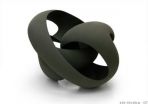(Press-News.org) Charlottesville, VA (December 11, 2012). Neurosurgeons at All Children's Hospital/Johns Hopkins Medicine (St. Petersburg, FL) and the University of South Florida Morsani College of Medicine (Tampa, FL) recently achieved excellent physical and aesthetic results in an infant born with extreme macrocephaly due to hydrocephalus. This was accomplished with routine implantation of a ventriculoperitoneal shunt followed by a new operation to stabilize and reduce the size of the baby's head. Both surgeries were performed during the infant's first week of life. The surgeons report that as far as they know, this is the first reported case of cranial fixation in such a young child with extreme hydrocephalus. Full details of the surgical procedures and their successful outcomes can be found in the article "Cranial reduction and fixation with a resorbable plate combined with cerebrospinal fluid shunting for difficult-to-manage macrocephaly related to hydrocephalus," by Jotham Manwaring, M.D., and colleagues, published today online, ahead of print, in the Journal of Neurosurgery: Pediatrics.
In this article the authors report the case of an infant born with extreme macrocephaly. The baby's head measured 50 cm in circumference (more than the 99th percentile). His anterior fontanel bulged, and there was wide separation between the bones of all cranial sutures (see accompanying figure). Magnetic resonance imaging confirmed the diagnosis of severe hydrocephalus.
When the infant was 2 days old, surgery was performed to implant a ventriculoperitoneal shunt with a programmable valve. The performance level of the valve was adjusted repeatedly over the next few days to balance drainage of cerebrospinal fluid (CSF). Despite multiple shunt valve adjustments, a satisfactory balance could not be achieved to allow sufficient CSF drainage without creating a dysmorphic skull appearance. This often occurs in infants with congenital hydrocephalus and markedly enlarged skulls. The surgeons decided to perform a cranial reduction and stabilization procedure in an effort to improve the child's appearance, to facilitate his care, and to allow adequate CSF drainage without resulting in skull bone overlap.
Gerald Tuite, M.D., and Devon Truong, P.A.-C, the developers of the procedure, together with their colleagues began the operation by creating an incision just behind the anterior fontanel. The surgical team drained enough CSF from the ventricles to bring both frontal and parietal bones together, resulting in a far better shape of the infant's head. The team placed a resorbable plate across the entire anterior fontanel and affixed the parietal and frontal bones firmly in place. This prevented the development of unsightly overlaps, which commonly occur when a skull is disproportionately large compared to the size of the underlying brain. The procedure took 45 minutes and the infant tolerated it well. Immediately postoperatively, the shape of the infant's head was much improved and it was much easier to care for him. There was no longer the need for frequent repositioning or shunt valve adjustments to try to regulate head shape. Not only were the cranial bones held solidly in place, but the cranial volume was reduced by approximately 49%.
Follow-up examinations showed that as the child became older, his cranial bones grew over the anterior fontanel to meet at the sutures and the implanted plate was absorbed by the body. At 17 months, the infant displayed near-normal development (with a slight motor delay) and required no medication or additional surgery. The shunt is still in place and functioning well. The infant's appearance remains excellent.
The importance of this paper is the timing of the cranial reduction and stabilization procedure. It was accomplished shortly after shunt implantation, within the first week of life—much earlier than reported in other papers. The authors state that this early intervention was much less technically challenging than later reconstructions, which sometimes require more than one surgical procedure, can carry more risks, and may not achieve the aesthetic outcome desired. In this case, only one 45-minute reconstructive surgery was required. The authors also suggest that further modifications of their procedure could make it simpler and even possibly include shunt implantation during the same surgery.
Using the technique described in this paper, the authors state, "Early shunting combined with a limited cranial reduction and fixation procedure facilitated patient positioning, simplified management of hydrocephalus, and provided an excellent aesthetic outcome in an infant with extreme macrocephaly related to hydrocephalus."
###
Manwaring JC, Truong D, Deukmedjian AR, Carey CM, Storrs BB, Rodriguez LF, Tetreault L, Tuite GF. Cranial reduction and fixation with a resorbable plate combined with cerebrospinal fluid shunting for difficult-to-manage macrocephaly related to hydrocephalus. Journal of Neurosurgery: Pediatrics, published online, ahead of print, December 11, 2012; DOI: 10.3171/2012.10.PEDS12340.
Disclosure: The authors report no potential conflict of interest concerning the materials or methods used in this study or the findings specified in this paper.
For additional information, please contact:
Ms. Jo Ann M. Eliason, MA, ELS
Communications Manager
Journal of Neurosurgery Publishing Group
One Morton Drive, Suite 200
Charlottesville, VA 22903
Email: jaeliason@thejns.org
Telephone 434-982-1209
Fax 434-924-2702
The Journal of Neurosurgery: Pediatrics is a monthly peer-reviewed journal focused on diseases and disorders of the central nervous system and spine in children. This journal contains a variety of articles, including descriptions of preclinical and clinical research as well as case reports and technical notes. The Journal of Neurosurgery: Pediatrics is one of four monthly journals published by the JNS Publishing Group, the scholarly journal division of the American Association of Neurological Surgeons, an association dedicated to advancing the specialty of neurological surgery in order to promote the highest quality of patient care. The Journal of Neurosurgery: Pediatrics appears in print and on the Internet. END
Extreme macrocephaly treated by shunting & cranial reduction/fixation in 1st week of life
2012-12-11
ELSE PRESS RELEASES FROM THIS DATE:
Study finds epigenetics, not genetics, underlies homosexuality
2012-12-11
KNOXVILLE – Epigenetics – how gene expression is regulated by temporary switches, called epi-marks – appears to be a critical and overlooked factor contributing to the long-standing puzzle of why homosexuality occurs.
According to the study, published online today in The Quarterly Review of Biology, sex-specific epi-marks, which normally do not pass between generations and are thus "erased," can lead to homosexuality when they escape erasure and are transmitted from father to daughter or mother to son.
From an evolutionary standpoint, homosexuality is a trait that ...
No need to prepare
2012-12-11
For the first time, researchers sequenced DNA molecules without the need for the standard pre-sequencing workflow known as library preparation.
Using this approach, the researchers generated sequence data using considerably less DNA than is required using standard methods, even down to less than one nanogram of DNA; 500 times less DNA than is needed by standard practices.
Libraries are collections of DNA fragments derived from genomic samples using molecular biology techniques specific to the sequencing technology being used. They are laborious, time consuming, and ...
An elusive effect measured during the last Venus transit
2012-12-11
A team of Italian astronomers performed a very difficult measurement for which it was necessary to use the most advanced instrumentation in combination with an unusual technique, so as to involve even the Moon as a natural astronomical mirror. The challenge was the observation of effect occurred during the transit of Venus across the Sun on June 6th, dubbed "Rossiter-McLaughlin effect". This is a phenomenon that occurs when a celestial body passes in front of a star, hiding a part of its rotating surface and that produces a temporary distortion in the profiles of the spectral ...
Tiotropium has advantages for patients with COPD
2012-12-11
In order to widen the narrowed airways in patients with chronic obstructive pulmonary disease (COPD), tiotropium bromide (tiotropium in brief) is one of the drugs available that can be prescribed for inhalation. The German Institute for Quality and Efficiency in Health Care (IQWiG) has examined whether tiotropium offers a perceptible advantage to patients compared to a dummy medication (placebo) and to other COPD drugs. In addition, the two currently marketed types of inhaler (HandiHaler and Respimat) for tiotropium (trade name: Spiriva®) were compared.
According to ...
Employers maintain training budgets despite recession, research shows
2012-12-11
British employers have avoided slashing their budgets for training during the recession because they believe it is vital to their operations, a new study has found.
Researchers analysed figures from various surveys showing that spending in real terms on training fell by only 5% from 2007 to 2009, and has remained steady since. They also spoke to managers from 52 companies and found that almost all remained committed to keeping their training schemes going.
In an article in the December edition of the journal Work, Employment and Society, the researchers say that "a ...
Researchers identify new components of the epigenetic 'code' for honey bee development
2012-12-11
Researchers from the UK and Australia have uncovered a new element of the honeybee's genetic makeup, which may help to explain why bees are so sensitive to environmental changes.
Scientists from the University of Sheffield, Queen Mary, University of London and the Australian National University, have found that honeybees have a 'histone code' – a series of marks on the histone proteins around which their DNA is wrapped in order to fit into the nucleus of a cell. This code is known to exist in humans and other complex organisms in order to control changes in cell development ...
Does the brain become unglued in autism?
2012-12-11
Philadelphia, PA, December 11, 2012 – A new study published in Biological Psychiatry suggests that autism is associated with reductions in the level of cellular adhesion molecules in the blood, where they play a role in immune function.
Cell adhesion molecules are the glue that binds cells together in the body. Deficits in adhesion molecules would be expected to compromise processes at the interfaces between cells, influencing tissue integrity and cell-to-cell signaling. In the brain, deficits in adhesion molecules could compromise brain development and communication ...
A mobile app helps children with special needs improve language and social skills
2012-12-11
University of Granada researchers have developed a cell phone that can be downloaded free from App Store and improves basic competences (maths, language, knowledge of the environment, autonomy and social skills) in children with autism-related disorders or Down Syndrome.
This application--named Picaa--can be used on iPhone, iPad and iPod touch and has been translated into several languages (English, Galician, Arab, etc.). This application has topped the 20,000 downloads from App Store--mainly from Spain and the USA--since its release. Picaa is a system designed for the ...
New knowledge about the remarkable properties of black holes
2012-12-11
Black holes are surrounded by many mysteries, but now researchers from the Niels Bohr Institute, among others, have come up with new groundbreaking theories that can explain several of their properties. The research shows that black holes have properties that resemble the dynamics of both solids and liquids. The results are published in the prestigious scientific journal, Physical Review Letters.
Black holes are extremely compact objects in the universe. They are so compact that they generate an incredibly strong gravitational pull and everything that comes near them ...
Anti-aging gene identified as tumor suppressor in mice, research finds
2012-12-11
ANN ARBOR, Mich. — A new study sheds more light on how an anti-aging gene suppresses cancer growth, joint University of Michigan Health System and Harvard Medical School research shows.
Loss of the SIRT6 protein in mice increases the number, size and aggressiveness of tumors, according to the new research published in the scientific journal Cell. The study also suggests that the loss of SIRT6 promotes tumor growth in human colon and pancreatic cancers.
"It is critical to understand the spectrum of genes that suppress tumor development," says co-senior author David Lombard, ...


